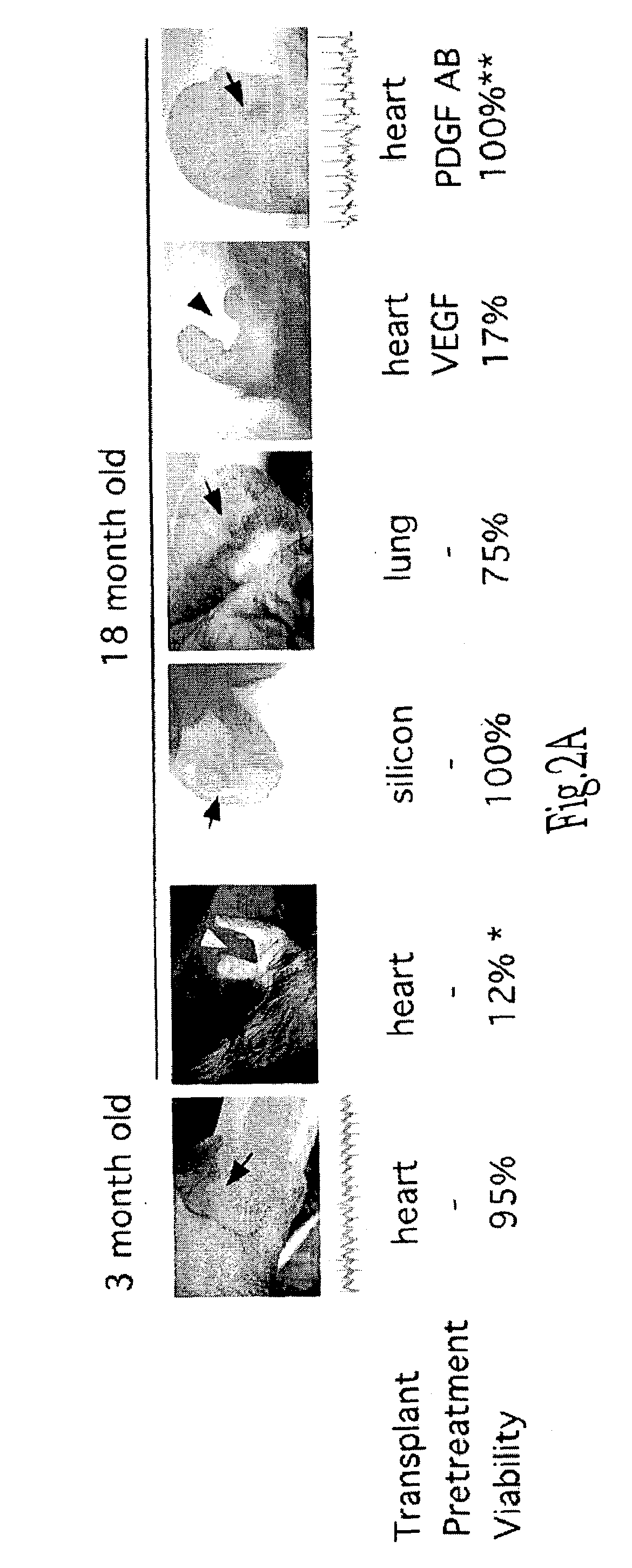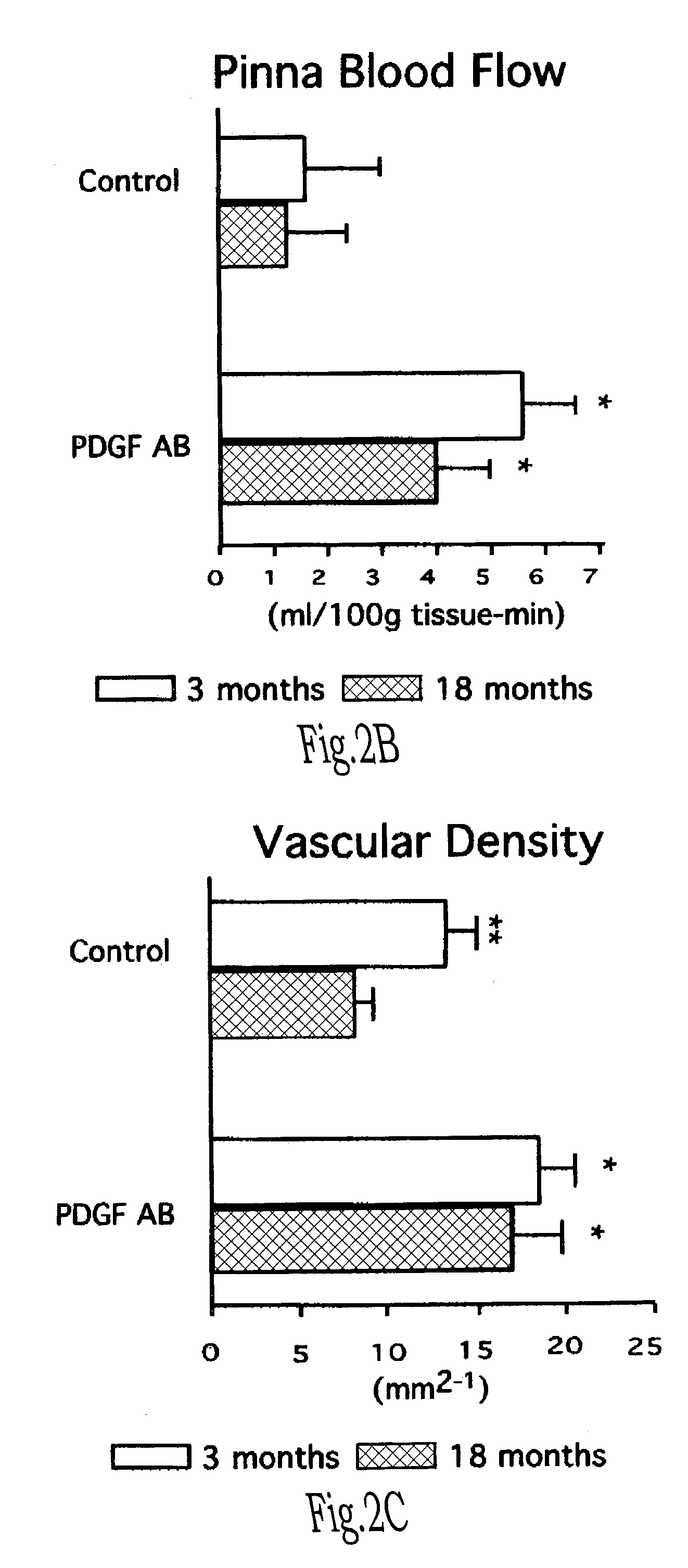Endothelial precursor cells for enhancing and restoring vascular function
- Summary
- Abstract
- Description
- Claims
- Application Information
AI Technical Summary
Benefits of technology
Problems solved by technology
Method used
Image
Examples
example 1
Endothelial Precursor Cells Restore Angiogenesis
[0216]This Example provides data illustrating that endothelial dysregulation in the PDGF communication pathway underlies the impairment in senescent cardiac angiogenic potential and that young adult BM-derived endothelial precursor cells can reverse this defect and restore cardiac angiogenesis in the aging host.
Methods
[0217]Molecular Studies
[0218]Samples of the ventricular myocardium were isolated from 3 month old (n=3) and 18 month old C57B61 / L mice (n=3). Total RNA was isolated (RNeasy and QIAshedder kits, Qiagen Valencia Calif.) and analyzed by RT-PCR (Hotstar Taq PCR, Qiagen) for expression of PDGF A and PDGF B as well as β-actin. Cardiac microvascular endothelial cells (CMECs) were isolated from 3 month old and 18 month old C57B61 / L mice and cardiac myocytes from fetal murine hearts, as previously described. Edelberg et al. J Clin Invest. 1998: 102:837–43; Aird et al. J. Cell Biol. 1997: 138: 1117–24; Edelberg et al. J Clin Invest...
example 2
PDGF-AB Stimulates Cardiac Myocyte Derivation from Aging Bone Marrow
[0249]This Example provides data illustrating that aging bone marrow cells failed to generate cardiac myocytes and fail to express PDGF-B. However, addition of PDGF-AB restored the cardioplastic potential of aging bone marrow cells and stimulated formation of functional cardiac myocytes that expressed myosin heavy chain and exhibited chronotropic activity in vivo.
Methods
[0250]Cell Isolation and Culture
[0251]Bone marrow cells were isolated from 3 and 18 month-old wild-type C57B1 / 6 mice (Harlan Sprague-Dawley, Indianapolis, Ind.; n=3 each). The mice were sacrificed and the tibias and femurs removed and cut proximally and distally. The bone marrow was flushed with 2% BSA in PBS. The cellular pellets were washed with PBS and plated into 12-well dishes with Iscove's Modified Dulbecco's Medium supplemented with 10% fetal calf serum, 50 μg / mL heparin, 100 μg / mL penicillin, 100 μg / mL streptomycin, 5 ng / mL fibroblast growth ...
example 3
Transplanted Genetically-Modified Endothelial Precursor Cells are Incorporated and Participate in Neovascularization of Syngeneic Adult Cows
[0268]This Example describes experiments where a marker gene was inserted into the genome of primary cultures of bovine fibroblasts, the fibroblasts were fused with enucleated bovine oocytes, and fetal liver cells were isolated from the resulting embryos. After these fetal liver cells were injected intravenously into syngeneic adult cows, the marker gene was detected in the vascular endothelium of the cows.
Methods
[0269]Fibroblast Isolation
[0270]General procedures were employed for isolating and growing fibroblast cells from skin and lung tissue. See, for example, U.S. Pat. No. 6,011,197 (Strelchenko et al.), and in U.S. Pat. No. 5,945,577 (Stice et al.), the contents of both of which are incorporated herein by reference in their entirety.
[0271]The methods employed were generally as follows. Minced tissue was incubated overnight at 10° C. in tryp...
PUM
 Login to View More
Login to View More Abstract
Description
Claims
Application Information
 Login to View More
Login to View More - R&D
- Intellectual Property
- Life Sciences
- Materials
- Tech Scout
- Unparalleled Data Quality
- Higher Quality Content
- 60% Fewer Hallucinations
Browse by: Latest US Patents, China's latest patents, Technical Efficacy Thesaurus, Application Domain, Technology Topic, Popular Technical Reports.
© 2025 PatSnap. All rights reserved.Legal|Privacy policy|Modern Slavery Act Transparency Statement|Sitemap|About US| Contact US: help@patsnap.com



